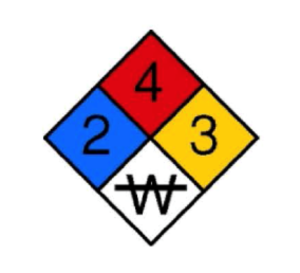What is NFPA 704 – Quick Tips
National Fire Protection Association (NFPA) 704 (Standard System for the Identification of the Hazards of Materials for Emergency Response) is a simple, readily recognized system used for identifying the hazards of materials and the severity of those hazards. A four section multicolor “square-on-point” (diamond/placard) is used to address the health, flammability, instability and special hazards presented by short-term, acute exposures that could occur during fires, spills or other similar emergencies.
Hazard Ratings
The severity of a hazard is indicated by a numerical rating that ranges from zero (minimal hazard) to four (severe hazard). The hazards are arranged and color-coded as follows:
- Health (blue) at nine o’clock
- Flammability (red) at twelve o’clock
- Instability (yellow) at three o’clock
- Special hazards (white) at six o’clock
Generally, special hazard symbols are kept to a minimum for emergency and simplicity reasons – W (unusual reactivity with water), OX (oxidizer) and SA (simple asphyxiant gas).

Assignment of Ratings
The assignment of these ratings is to be performed by a technically competent person who is experienced in interpreting the hazard criteria spelled out in Chapters 5 – 8 of NFPA 704. The competent person can determine the ratings for a material by using the information found on a Hazard Communication 2012 compliant Safety Data Sheet (SDS) and comparing it to the criteria. The following sections of the SDS should be reviewed when determining the rating:
- Health – Section 11
- Flammability – Section 9
- Instability – Section 10
- Special Hazards – Sections 9, 10, and 11
The hazard category numbers given in Section 2 of the SDS must not be used as the hazard ratings on the NFPA 704 diamond /placard.
A common question regarding the ratings is how to determine a number when there are a variety of different chemicals in the facility. Section 4.2.3.3 of NFPA 704 provides three different methods to rate multiple chemicals. A single sign can be used to summarize the maximum ratings contributed by the materials. The ratings for a chemical that contains multiple ingredients should be obtained from data for the mixture as presented on the SDS.
Location and Sizes
The NFPA 704 diamond / placard is meant to provide quick hazard information for emergency responders and therefore should be visible where responders are likely to enter. Local authorities have jurisdiction as to where and how many are needed, but NFPA suggests at a minimum the signs should be located on:
- Two exterior walls of a building or facility;
- Each access to a room or area; or
- Each principal means of access to an exterior storage area
The size of the diamond / placard is dependent on the distance at which the hazard ratings must be legible. The numbers should be visible from a minimum distance of 50 feet. NFPA 704 recommended distances and letter heights are outlined below:

NFPA 704 and the Revised Hazard Communication Standard
One of the integral pieces of the Occupational Safety and Health Administration’s (OSHA’s) revised Hazard Communication Standard was the incorporation of Revision 3 of the United Nations’ Globally Harmonized System of Classification and Labeling of Chemicals (GHS). The revised standard requires the use of standardized “shipped container labels” and 16-section SDSs. However, the revised standard still allows for alternative methods of labeling workplace containers – such as the NFPA 704 labels.
Employers are required to ensure that containers in the workplace are labeled. You may replicate the “shipped container label” or you may label workplace containers with alternative labels, such as the NFPA 704 label. Containers of hazardous chemicals in the workplace must at a minimum include the product identifier and general information concerning the hazards of the chemical. Whatever method you choose, employees need to have access to complete hazard information.
Commonly Asked Questions
Q: Is the NFPA 704 a requirement? Who enforces this requirement?
A: The NFPA 704 standard is a voluntary standard. NFPA 704 signs are required when another federal, state or local regulation or code requires their use. Some of the more widely adopted and used NFPA codes that require 704 signs for specific occupancies, storage and hazardous materials include:
- NFPA 1 – Fire Code
- NFPA 30 – Flammable and Combustible Liquids Code
- NFPA 45 – Standard on Fire Protection for Laboratories Using Chemicals
- NFPA 55 – Compressed Gases and Cryogenic Fluids Codes
- NFPA 400 – Hazardous Materials Code
Source
NFPA 704 Standard System for the Identification of the Hazards of Materials for Emergency Response – 2012 Edition
The information contained in this article is intended for general information purposes only and is based on information available as of the initial date of publication. No representation is made that the information or references are complete or remain current. This article is not a substitute for review of current applicable government regulations, industry standards, or other standards specific to your business and/or activities and should not be construed as legal advice or opinion. Readers with specific questions should refer to the applicable standards or consult with an attorney.
Source: Grainger Know How – https://www.grainger.com/know-how